To plane a tabletop with an electric planer, secure the wood firmly on a flat surface. Move the planer evenly across the surface, applying consistent pressure.
Planing a tabletop can transform rough wood into a smooth, finished surface. An electric planer simplifies this task, making it quick and efficient. It’s perfect for preparing wood for furniture or other projects. Understanding how to use this tool correctly is essential for achieving the desired results.
Proper techniques ensure you avoid common pitfalls like snipe or uneven surfaces. With practice, you’ll gain confidence and skill, allowing you to create beautifully finished tabletops. This guide will walk you through each step, ensuring a smooth and successful planing experience. Get ready to enhance your woodworking projects with ease!
Introduction To Table Top Planing
Planing a table top gives it a smooth and level surface. An electric planer makes this task easier and quicker. This guide will help you understand how to achieve a flat table top efficiently.
Why A Flat Table Top Matters
A flat table top is essential for various reasons:
- Stability: A flat surface provides better support for items.
- Aesthetics: Smooth surfaces look more appealing.
- Functionality: It allows for better use of the table.
- Durability: A flat surface reduces wear and tear.
Uneven surfaces can cause issues. They can lead to wobbling furniture. They can also affect the overall design. Flat surfaces enhance both form and function.
Tools Needed For Planing
To successfully plane a table top, gather these tools:
| Tool | Description |
|---|---|
| Electric Planer | Powerful tool for removing wood material. |
| Clamps | Hold the table securely while planing. |
| Measuring Tape | Ensure accurate dimensions before planing. |
| Safety Goggles | Protect your eyes from wood shavings. |
| Dust Mask | Keep dust from entering your lungs. |
Having the right tools makes the process smoother. Check your equipment before you start. This ensures a safe and efficient planing experience.
Safety First: Preparing To Use An Electric Planer
Using an electric planer can be exciting. Safety is crucial for a smooth experience. Proper preparation helps you avoid accidents. Let’s explore how to set up safely.
Personal Protective Equipment
Wearing the right gear is essential. Personal Protective Equipment (PPE) keeps you safe. Here’s a list of what you need:
- Safety Goggles: Protect your eyes from flying debris.
- Ear Protection: Electric planers can be loud. Use earplugs or earmuffs.
- Dust Mask: Prevent inhaling wood dust.
- Gloves: Use gloves for a better grip. Ensure they fit well.
- Non-slip Shoes: Wear sturdy shoes to avoid slips.
Workspace Setup
A tidy workspace boosts safety. Follow these steps to set up:
- Choose a Flat Surface: Use a stable workbench.
- Clear Clutter: Remove unnecessary items from the area.
- Check Lighting: Ensure good lighting for visibility.
- Secure the Material: Clamp the wood to prevent movement.
- Organize Tools: Keep tools within reach and organized.
Setting up correctly reduces risks. Always stay aware of your surroundings. Follow these steps for a safer planning experience.
Assessing The Table Top Condition
Before using an electric planer, assess the table top’s condition. This step ensures you achieve a smooth, even surface. Look for imperfections such as dips, warps, or scratches. Identifying these areas early saves time and effort later.
Spotting High And Low Areas
Begin by inspecting the surface closely. Use your hands and eyes to feel and see variations. Here are a few tips for spotting unevenness:
- Visual Inspection: Look for dips and bumps.
- Touch Test: Run your hand over the surface.
- Light Source: Shine a light across the surface.
Mark high and low areas with a pencil. This allows you to focus on specific spots while planing.
Marking The Table For Planing
Once you identify the high and low areas, it’s time to mark them clearly. Use a straightedge or a level to guide you. Follow these steps:
- Place the straightedge across the table.
- Look for gaps between the straightedge and the table.
- Mark the high spots with a pencil.
- Note the low spots for reference.
These marks help guide your electric planer. Focus on the high spots first. This will ensure an even finish.

Setting Up The Electric Planer
Setting up your electric planer correctly is crucial. Proper setup ensures smooth results and a safe working environment. Follow these steps to prepare your tool effectively.
Choosing The Right Blades
Selecting the appropriate blades is essential for effective planing. Blades come in different types and sizes. Here’s how to choose the right ones:
- Material: Choose high-speed steel (HSS) for durability.
- Width: Match the blade width to your planer model.
- Condition: Inspect for dullness or damage. Replace if needed.
Using sharp blades improves cutting efficiency. Dull blades can lead to poor results.
Adjusting Depth And Angle
Proper depth and angle adjustments enhance performance. Follow these simple steps:
- Depth Setting: Adjust the depth knob. Set it between 1/32” to 1/16”.
- Angle Adjustment: Ensure the planer is level. This prevents uneven cuts.
- Test Run: Do a test cut on scrap wood. Check for evenness.
Correct adjustments lead to a smoother surface. Take your time for accurate settings.
The Planing Process
Planing a tabletop with an electric planer can transform rough wood into a smooth surface. This process is straightforward and rewarding. Follow these steps to achieve the best results.
Starting With The First Pass
Begin with a clean, flat surface. Ensure the wood is free from dirt and debris. Here are the steps:
- Set the depth: Adjust the depth of the electric planer. Start with a shallow cut.
- Secure the wood: Clamp the wood securely to prevent movement.
- Position the planer: Hold the planer firmly with both hands.
- Make the first pass: Start at one end and move to the other.
Watch for any uneven areas. Repeat the process until you reach the desired thickness.
Techniques For Smooth Planing
Using the right techniques ensures a smooth finish. Here are some tips:
- Maintain a steady pace: Keep a consistent speed while planing.
- Overlap passes: Overlap each pass slightly for an even surface.
- Check for snipe: Watch for any dips at the ends. Adjust your technique if needed.
- Use sharp blades: Dull blades can cause tear-out. Replace them regularly.
Always check the surface with your hand. Feel for any rough spots. A smooth surface will make finishing easier.
Troubleshooting Common Planing Issues
Planing a tabletop with an electric planer can be rewarding. Yet, issues may arise. Understanding common problems helps you fix them quickly. Here’s how to tackle two frequent challenges.
Dealing With Tear-out
Tear-out occurs when wood fibers tear away during planing. This can ruin your smooth finish. Here are ways to prevent and fix tear-out:
- Use Sharp Blades: Dull blades cause more tear-out.
- Adjust Planer Depth: Take shallower passes. This reduces stress on the wood.
- Feed Direction: Always plane in the direction of the grain.
- Backer Board: Use a backer board for support. This helps prevent tear-out.
When tear-out happens, you can fix it by:
- Lightly sanding the area.
- Using wood filler for deep tears.
- Re-planing the area carefully.
Ensuring Even Thickness
Uneven thickness is a common problem. It affects the look and usability of your tabletop. Follow these tips for consistent thickness:
- Mark Reference Lines: Draw lines on the wood surface.
- Check Thickness Regularly: Measure often with calipers or a ruler.
- Use a Straight Edge: Guide the planer along a straight edge.
For checking thickness:
| Action | Frequency |
|---|---|
| Measure Thickness | Every pass |
| Check Blade Sharpness | Before starting |
| Inspect for Tear-Out | After each pass |
By following these tips, you can achieve an even thickness. This ensures a professional finish on your tabletop.
Finishing Touches
After planing your table top, finishing touches make it shine. These steps ensure durability and beauty. Focus on sanding and applying a protective finish.
Sanding The Table Top
Sanding prepares the surface for finishing. It smooths out any rough spots from the planer.
- Use a random orbit sander for best results.
- Start with 120-grit sandpaper.
- Progress to 220-grit for a fine finish.
Sand in the direction of the grain. This prevents scratches. Pay special attention to edges and corners.
After sanding, wipe the surface with a damp cloth. This removes dust and debris. Let it dry completely before applying any finish.
Applying Finish For Protection
Applying a finish protects the wood. It enhances the beauty of the grain.
| Finish Type | Benefits |
|---|---|
| Polyurethane | Durable and water-resistant |
| Oil Finish | Easy to apply; enhances grain |
| Varnish | Offers UV protection |
Choose a finish that suits your table’s purpose. Use a brush or cloth for application. Apply thin coats. Allow each coat to dry before adding another. Sand lightly between coats for a smooth finish.
After the final coat, let the table cure for several days. This ensures full protection. Enjoy your beautifully finished table top!
Maintaining Your Electric Planer
Proper maintenance keeps your electric planer in top shape. It ensures longevity and performance. Regular care prevents costly repairs and enhances accuracy.
Cleaning After Use
Cleaning your electric planer is vital after every use. Dust and debris can affect performance. Follow these steps:
- Unplug the planer for safety.
- Use a soft brush to remove wood shavings.
- Wipe the exterior with a damp cloth.
- Check vents for dust buildup and clean them.
Regular cleaning helps maintain optimal performance. Store the planer in a dry place after cleaning.
Blade Care And Replacement
Sharp blades improve cut quality. Regularly check the blades for dullness or damage. Follow this simple care routine:
- Inspect blades after each use.
- Sharpen blades when they become dull.
- Replace blades if damaged or chipped.
To replace the blades:
- Unplug the planer.
- Remove the blade guard.
- Loosen the screws holding the blades.
- Install new blades and tighten screws.
Use the manufacturer’s recommended blades for best results. Proper blade care ensures smooth and efficient planing.
Advanced Tips For Professional Results
Achieving a smooth and professional finish on your table top requires skill and precision. Here are some advanced tips to elevate your results using an electric planer.
Using Jigs For Consistency
Jigs help maintain uniformity while planing. They ensure even pressure and alignment throughout the process. Follow these steps to create a jig:
- Measure the width of your table top.
- Cut two pieces of plywood to the same length as the top.
- Attach the plywood pieces parallel to each other.
- Secure the jig with clamps before planing.
Benefits of using jigs:
- Consistent thickness across the surface.
- Reduced risk of uneven spots.
- Improved safety during operation.
Combining Tools For Efficiency
Pairing your electric planer with other tools can save time and effort. Consider these combinations:
| Tool | Purpose | Benefit |
|---|---|---|
| Table Saw | Cut to size | Perfect edges for planing |
| Joiner | Flatten edges | Better alignment for planing |
| Sander | Final finish | Smooth surface after planing |
Using multiple tools together enhances your workflow. Efficiency increases, allowing for quicker project completion.
Conclusion: Enjoying Your Renewed Table Top
After planning your table top with an electric planer, satisfaction awaits. Your hard work transforms rough wood into a smooth surface. This process enhances the beauty and function of your table. Let’s reflect on the journey and plan future projects.
Reflecting On The Process
Take a moment to appreciate your effort. Every step taught you valuable skills.
- Understanding the electric planer.
- Learning to measure accurately.
- Gaining confidence in woodworking.
Admire your newly smooth table top. The grain shines through the finish. This table now holds stories and memories.
Planning Your Next Woodworking Project
Now that you’ve gained experience, what’s next? Consider these ideas:
- Build a matching set of chairs.
- Create a coffee table with unique designs.
- Craft shelves to display your favorite items.
Each project offers a chance to improve your skills. Gather materials and tools now. Your next masterpiece awaits!

Frequently Asked Questions
How Do I Choose The Right Electric Planer?
Choosing the right electric planer involves considering power, blade size, and weight. Look for a model that suits your project needs. A higher wattage means better performance. Also, choose a planer with adjustable depth settings for versatility. Always read reviews to ensure quality and durability.
What Safety Gear Should I Wear While Planing?
When planing, always wear safety goggles to protect your eyes. Ear protection is essential due to the noise of the electric planer. A dust mask helps prevent inhaling wood particles. Additionally, consider gloves to improve grip and protect your hands from sharp edges.
Safety first ensures a smooth project.
How Do I Maintain My Electric Planer?
To maintain your electric planer, keep the blades sharp for clean cuts. Regularly clean the body and dust port to prevent buildup. Store the tool in a dry place to avoid rust. Check electrical cords for wear and replace them if damaged.
Proper maintenance prolongs the tool’s lifespan.
Can I Use An Electric Planer On Hardwood?
Yes, you can use an electric planer on hardwood. However, ensure your planer has sufficient power to handle the density. Adjust the depth settings to avoid overloading the tool. Take your time and make multiple passes for a smoother finish.
Always follow the manufacturer’s guidelines for best results.
Conclusion
Planing a table top with an electric planer can transform your woodworking projects. By following the right techniques, you’ll achieve a smooth, professional finish. Remember to practice safety measures and take your time. With patience and skill, you can create beautiful pieces that enhance any space.
Happy planing!

